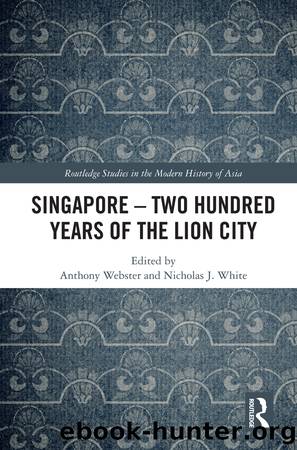Singapore â Two Hundred Years of the Lion City by Anthony Webster Nicholas J. White

Author:Anthony Webster, Nicholas J. White [Anthony Webster, Nicholas J. White]
Language: eng
Format: epub
ISBN: 9781032086859
Barnesnoble:
Publisher: Taylor & Francis
Published: 2021-06-30T00:00:00+00:00
Conclusion: the long-term implications of commercial dominance
What then are the main implications of the dominance of commercial interests for an examination of the development of Singapore and British interests in Southeast Asia? Firstly, this was undoubtedly a factor in the continued rise and success of Singapore under British rule. It meant that the interests of commerce, of all ethnicities, occupied an important position of influence in policy formation in the Straits settlements, and later in the Malay States as British influence and power expanded there after 1874. Secondly, and deriving from this factor, it was an important reason why the Malay states came to occupy such a prominent position within the British Empire, especially within the fields of first tin and later rubber production. Thirdly, it also allowed the growth of cross-regional networks and infrastructures which connected commercial interests in the Dutch and British spheres in Southeast Asia, as demonstrated in Kawamuraâs chapter in this volume. This provided the basis for future success in such commodities as palm oil, extending even into the postcolonial period. Fourthly, the strong links between British and Straits and Southeast Asian interests continued under British rule and indeed after â again helping underpin the longer-term success of Singapore.
From the point of view of the history of the British Empire, the hegemony of commercial interests in the Straits points to the potential value of comparison with imperial arrangements at other British ports in Asia (such as Hong Kong), India (Bombay and Calcutta) and elsewhere in the empire. How unique was Singapore and the Straits, and to what extent were efforts made to replicate aspects of the âStraits systemâ elsewhere? Nealâs work on Singapore as a template for managing labour migration, and Jonesâ identification of the Straits Settlements as a model followed by the China Association, certainly suggests anecdotally that this was the case. More systematic comparisons might reveal other examples of efforts to apply lessons learned in the Straits to other imperial contexts. Perhaps, in respect of the position of Singapore and the Straits Settlements, the British Empire proved itself a âlearning empireâ which adapted successful initiatives to other contexts. Such a development would suggest that the British Empire was, in some instances at least, more than just the pragmatic and ad hoc creation by âreluctant imperialistsâ of exclusively localised customised and unique systems of rule. It might help give the lie to that old notion of the âabsent-mindedâ imperialist.82
Download
This site does not store any files on its server. We only index and link to content provided by other sites. Please contact the content providers to delete copyright contents if any and email us, we'll remove relevant links or contents immediately.
The Rape of Nanking by Iris Chang(3530)
The Sympathizer by Viet Thanh Nguyen(3528)
World without end by Ken Follett(3016)
Ants Among Elephants by Sujatha Gidla(2930)
Blood and Sand by Alex Von Tunzelmann(2615)
Japanese Design by Patricia J. Graham(2564)
City of Djinns: a year in Delhi by William Dalrymple(2140)
Inglorious Empire by Shashi Tharoor(2108)
In Order to Live: A North Korean Girl's Journey to Freedom by Yeonmi Park(2064)
Foreign Devils on the Silk Road: The Search for the Lost Treasures of Central Asia by Peter Hopkirk(2061)
Tokyo by Rob Goss(2025)
India's Ancient Past by R.S. Sharma(1994)
India's biggest cover-up by Dhar Anuj(1992)
The Great Game: On Secret Service in High Asia by Peter Hopkirk(1965)
Tokyo Geek's Guide: Manga, Anime, Gaming, Cosplay, Toys, Idols & More - The Ultimate Guide to Japan's Otaku Culture by Simone Gianni(1953)
Goodbye Madame Butterfly(1942)
The Queen of Nothing by Holly Black(1768)
Living Silence in Burma by Christina Fink(1738)
Batik by Rudolf Smend(1726)
